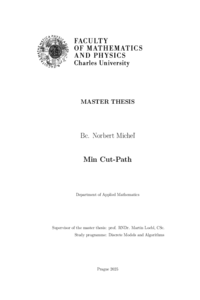Minimalni rez-cesta
Min Cut-Path
diploma thesis (DEFENDED)

View/
Permanent link
http://hdl.handle.net/20.500.11956/200007Identifiers
Study Information System: 281382
Collections
- Kvalifikační práce [11462]
Author
Advisor
Referee
Tiwary, Hans Raj
Faculty / Institute
Faculty of Mathematics and Physics
Discipline
Computer Science - Discrete Models and Algorithms
Department
Department of Applied Mathematics
Date of defense
13. 6. 2025
Publisher
Univerzita Karlova, Matematicko-fyzikální fakultaLanguage
Czech
Grade
Excellent
Keywords (Czech)
graf|hranovy rez|cestaKeywords (English)
graph|edge-cut|pathTato diplomová práce se zabývá problémem minimalni rez-cesta: hledáním minimální množiny hran, která současně obsahuje u-v řez i u-v cestu v grafu. Spojení těchto dvou konceptů zvyšuje složitost problému nad rámec standardních algoritmů pro řez nebo cestu. Identifikujeme a analyzujeme podmínky, za kterých má problém minimalni rez-cesta efektivní řešení. Pro grafy s průměrem nebo řezem nanejvýš dva, tedy když pro všichni x,y d(x,y) <= 2 nebo c(x,y) <= 2, navrhujeme polynomiální algoritmus pro případ c(u,v) = 2, založený na dekompozici pomocí obecných čtvercových grafů. V Erdős-Rényi náhodných grafech prezentujeme aproximační schéma s průměrnou zárukou přesnosti libovolně blízké 1. Dále navrhujeme téměř polynomiální algoritmus pro řídké instance. Nakonec se zabýváme symetrickým případem c(u,v) = d(u,v) = cp(u,v) a poskytujeme polynomiální algoritmy pro rozpoznání této vlastnosti a pro hledání řešení v téměř 5-regulárních grafech.
This thesis addresses the Min Cut-Path problem: finding a minimal set of edges that simultaneously contains both a u-v cut and a u-v path in a graph. The combination of these two concepts increases the complexity of the problem beyond that of standard algorithms for cuts or paths. We identify and analyze the conditions under which the Min Cut-Path problem allows efficient solutions. For graphs with diam or cut 2, that is, for all x, y with d(x,y) <= 2 or c(x,y) <= 2, we propose a polynomial-time algorithm for the case c(u, v) = 2, based on a decomposition using general square graphs. In Erdős-Rényi random graphs, we present an approximation scheme with an average-case guarantee arbitrarily close to 1. Furthermore, we propose an almost polynomial-time algorithm for sparse instances. Finally, we study the symmetric case c(u,v) = d(u,v) = cp(u,v) and provide polynomial-time algorithms for recognizing this property and finding solutions in nearly 5-regular graphs.
